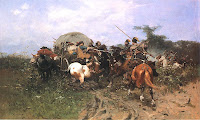Salve,
I have been dormant most of this winter and it looks as the spring may come to this corner of the Great Plains soon. I did very little riding past 2 months, and have been dreaming about some long distance riding in the Rocky Mountains - the most I have don is 30 miles in saddle...
So reading about riders of the past I decided to start my retunr to this blog with some recollections on men,woman and horses that made some of the longest rides in last 120 years.
First could come travellers of Asia, the largest land mass on this Earth.
Allow me to start with a fine rider, gentleman and military man
Kozak officer Dmitri Peshkov
(Дмитрий Пешков), member of Amur Cossack Voisko/Host, who crossed Imperial Russia astride a grey horse (photo above) named Serko
(Серко) - a Manchurian horse - notabene about this famous ride Russians made a movie in 2006.
Dmitri and Serko rode "five thousand five hundred miles in one hundred and ninety-three days" (or 9000km in 193 days) from Blagoveshchensk on the Amur River in Siberia to Saint Petersburg on the Baltic Sea during the late 1889 to May 1890. Gospodin Dmitiri was decorated by the Tsar with an order of St.Anna and a leave from his military duty, and he then travelled to Palestine to visit the Holy Land. He fought in Boxer Rebellion, being a member of invading Russian army and later in Russo-Japanese war. Retired in 1908 with a rank of colonel of the Russian army, for his military service he was awarded not only plenty of Russian Imperial orders, but also Italian and French. Manchurian grey Serko died in Saint Petersburg and was buried there and his burial still exists.
There is a Russian book published in 2001 describing his adventures based on documents etc - Путешествие амурского казака Дмитрия Пешкова от Благовещенска до Петербурга. Here an article in Russian...
Next a Japanese officer and scion of a samurai family,
Fukushima Yasumasa, who from
Berlin, German Empire, started on horse ''Gaisen,'' left him in Moscow due to sickness, bought Russian horse ''Ural''(that bit him repeatedly) and in the
Altai Mountains(Kazakhstan) bought two Kazakh horses that took him to Russian port city
Vladivostok, and eventually these horses went to Japan - from February 1892 to June 1893,
some 488 days.
''MAJOR
YASUMASA FUKUSHIMA, military
attaché of the Japanese Legation in Berlin, has started on one of the longest rides on record. He proposes to travel on horseback to Tokyo, a distance estimated at ten thousand miles, exclusive of waterways, on which he will have to take to a boat. He expects to ride six days in the week, and to make from thirty to thirty-five miles a day. His journey will last about fifteen months, and will subject him to extremes of heat and cold and to the most varying conditions. He weighs one hundred and fifty-four pounds, and will carry with him fifty-eight pounds of luggage.'' (the Illustrated American, vol.10, 1892)
Fukushima continued his service in the Japanese Army (became a general) and wrote a book about his travel, in Japanese, titled ''
A travel in Central and Southern Asia''
Next three American Continents travellers who used famous Argentinian horse breed - the criollo - to accomplish their tasks:
most famous Aimé Tschiffely , in 1926-29 he rode from Buenos Aires, Argentina to NYC on two criollo horses Mancha and Gato, later wrote a book (and many others) about his ride, published in English under the title "Tschiffely's ride; ten thousand miles in the saddle from Southern Cross to pole star." by Simon in 1933.
[...]*...and finally completely unknown and unfortunately passed away, the giant of horse long distance travel, Polish teacher and breeder
Tadeusz Kotwicki who between 1995-97/98 rode from the end of
Patagonia in Argentina, along the Pacific side of South America to
Kansas, US. Pan Tadeusz had ridden in Asia prior to his Americas' adventure, in 1992 he rode a Akhla-Teke mare from
Jambyl Province, Kazakhstan to Moscow, Russia, some some 4000km in 120 days. He was also a breeder of Akhal-Teke horses in Poland.
The article below, from Polish daily, "Głos Pomorza" (Voice of Pomerania) from January 1997, tells us about the moment in his voyage when he reached Bogota, Colombia, that Pan Tadeusz was going to ride all the way to the Bering Straits, yet from the article given in the link (http://boskawola.blogspot.com/2012/03/wspomnienie-tadeusza-kotwickiego-28.html ), we learn that he finished his epic journey in Kansas. I hope to learn more about his voyage from article the author of the blog will publish in Polish magazine "Koński Targ" (Horse Market).
Returning to Pan Tadeusz ride, from the newspaper article we learn that he rode a 142cm-at-withers tall grey criollo mare, bought in Argentinian
Province of Santa Cruz, in '
Stag River' horse stud. 6 years old grey mare named ''Kropka'' (''Dot'') was gentled and trained by pan Tadeusz, who had brought his own saddle from Poland for this trip; during his trip rode her for 2-3 hours and walked the same distance, making daily 40-50km a day. During his passage through Peru, he was attacked by the Indian villagers, who believing a fold tale about a white man on a white(grey) horse eating children, beat him and he was only saved by a public official travelling with journalists.
well, until the next time
ps
by the way the so called Extreme Mustang Makeover finished in September last year and look at the winner of the Supreme Class
*
16th of June 2012, I am removing this fragment from the main body of the post -
South African Marianne du Toit, who allegedly followed the footsteps/hoofsteps of Tschiffely on two criollo horses, from 2002-04, claimed she had ridden from Buenos Aires to NYC and actually later wrote a book, Crying with Cockroaches, about her claims.
- due to the substantive and material claims against this story.
























